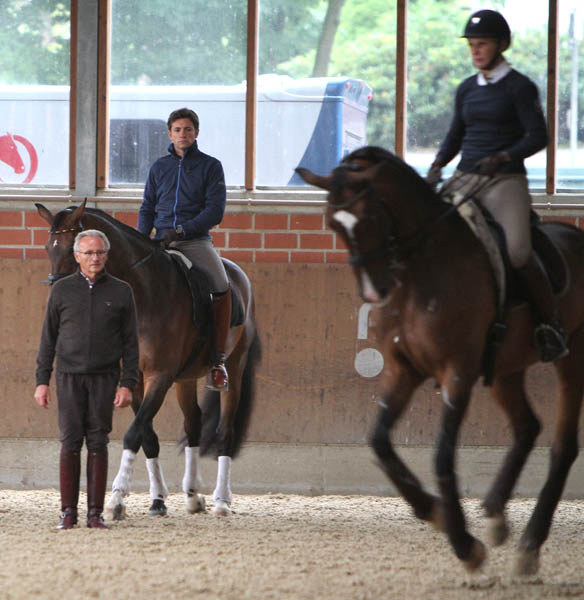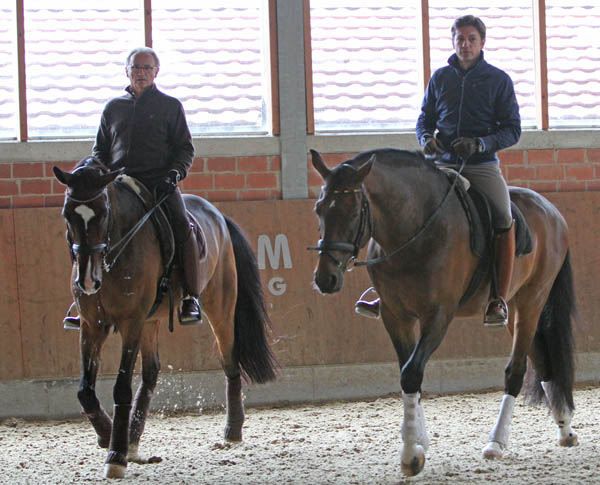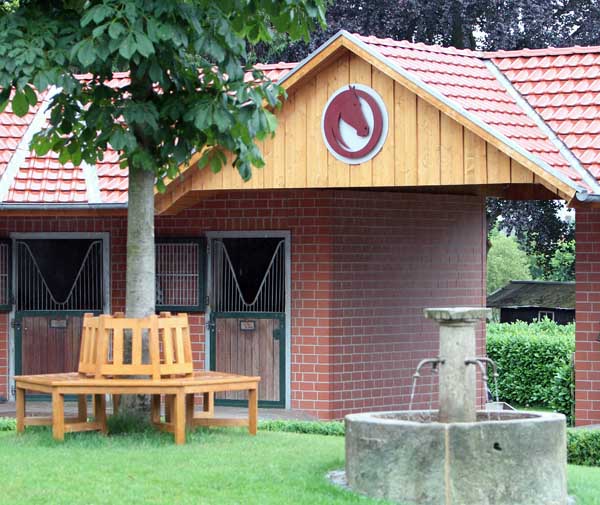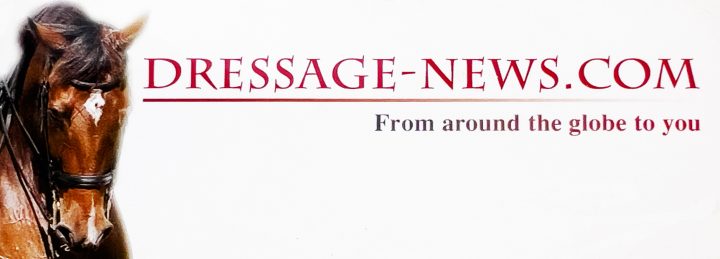Jürgen Koschel & 30 Years of Training Olympians
13 years ago StraightArrow Comments Off on Jürgen Koschel & 30 Years of Training Olympians

By KENNETH J. BRADDICK
HAGEN, Germany, July 13–When 25-year-old Kristina Sprehe rides Desperados into the Olympic dressage arena in London wearing the German flag in three weeks it will represent another success for a true master who has been coaching riders for 30 years on how to make it to the top of the sport.
Jürgen Koschel has been the coach with all it entails of some of the best Olympic horses and riders from Finland and Kyra Kyrklund and Nor at Los Angeles in 1984 and Matador in Seoul in 1998, the Spanish team in Atlanta in 1996, The Dutch silver medal team and individual gold medalist Anky van Grunsven and Bonfire in Sydney in 2000, Switzerland at Athens in 2004 but quit after team members would not go to the 2008 Games becaue they did not want to put their horses through the long trip to Hong Kong. Add, the Korean team at the 2006 Asian Games in Quatar and dozens of junior and young rider teams.
Now, at the age of 66 and one of only a handful of Germans with Class 1 Licenses for both dressage and jumping, Jürgen has coached Kristina from the Under-25 ranks to the Olympics and increased her scores by 10 percentage points to 80 per cent in a year.
“We really work on the little things, every little thing, because they are all important,” he told dressage-news.com. “It’s not only training the horses it’s training the riders as well.”
At a time when many trainers coach for success in competition, he is one of a declining number who work from the beginning using classical methods, preaching basics and, eqally important, having fun.
Christoph Koschel, his 36-year-old son, has been brought up with horses all his life and is taking over more of the globe-trotting teaching clinic duties that his father did for 30 years.
Christoph sold his Donnperignon after bronze-medal winning German teams at the 2010 World Equestrian Games and the 2011 European Championships.
The sale of the 13-year-old Finish Warmblood gelding (Donnerhall x Monserrat x Mozart 1179) to Denmark’s Anna Kasprzak left him with mixed emotions as the horse heads to the Olympics and its third championship in two years.
At the time of the sale to Anna, now aged 22, less than a year ago a host of top horses looked like they would seek to represent a nation whose team has won gold at every Olympics since the 1984 Games. Among them, Matthas Alexander Rath and Totilas, Isabell Werth with two horses, Ulla Salzgeber with Herzruf’s Erbe, who did not make it for various reasons. Instead, the team is made up of rookies, though no one doubts the talent of the riders and horses.
“I sometimes think what could have been,” he said. “But he is in a good family with good people who treat him well. It’s nice to see it works really well. It’s nice for us when judges and others say how amazing it is that he is on such a high level in such a short time.”

Susan Dutta, who has been on U.S. teams including reserve at two Pan American Games qualified for but skipped this year’s Olympic trials to move from Wellington, Florida, to Germany in April with her horses, most especially Currency DC.
“Jürgen is the ultimate professional of professionals, a master,” she said as grooms joked and greeted riders as they prepared horses to join or replace the half-dozen already in the indoor arena. Dogs, dodging horse’s legs, are as happy as the riders just to be part of the animal-loving atmosphere. There is, though, no mistaking the seriousness of the training in the domain of Jürgen and Christoph.
“The knowledge, the program… the teaching… the love of horses, the love of animals,” Susie said. “That’s why we’re all here.”
It is Jürgen’s spirit that permeates Hof Beckerode, the training center named for a community of Hagen that is 800 to 900 years old.
Over his active riding career he presented more than 110 horses from youngsters to the top levels earning more than 900 placings and victories, about one-third at international and national Grand Prix. His resumé includes receiving the German gold badge for success in dressage and jumping in 1975.
Jürgen’s expertise, knowledge and sucess is what attracts horses and riders from around the world to his stables–the current client list includes horses and riders from the United States, Portugal, Canada, Japan, Korea, Spain and Italy, more foreigners than Germans.
Germany’s Kristina Sprehe and Desperados began working with Jürgen three years ago and he has coached her through the Under-25 Division to the Olympics.

The reasons?
“I am not a friend of extremes,” Jürgen said. “We teach the classical methods, to be fair to horses.
“It is important to bring juniors and young riders along in a good way so they continue in the sport. A lot, of course, depends on the horse. For Kristina, it was great luck to have a horse like Desperados.
“The first years for horses and riders are very important. Our philosphy is to take care of basics, that is the most important factor. We do what is the best for every horse, every different horse and to find a way to make the best of it.
“When we start with 13 to 14-year-old kids we take care not to push them too much. When children go through puberty you have to be careful that it doesn’t get too much or too hard for them and the horses. It is a very sensitive age and you have to help them through the crises they go through.
“Young people have to stay happy with the horses to stay in the sport. It is a mix of discipline and fun.
“The horse is not a sport machine, but a partner. It is not a question of money, it is really a question of talent. You can buy a lot of horse with money, but you cannot buy talent.
“The hardest job of a trainer is to find out whether the young riders have talent and to do the sport right, not to ask too much. And when they have problems at home or at school you need to understand the pressures they feel and help to take care of them. That’s the reason we are very close to the children and their families.”

For the Koschels it is not just directed to the next championship.
And the basics do not mean only for horses, which tend to receive most attention with veterinarians, masseurs, chiropractors, farriers, and other efforts to maintain and improve a top athlete in any sport.
The Koschels try to tap into the rider and embrace new methods that can hep the rider achieve better results in the same way horses are treated to produce top performances.
“The trainer has a lot of influence, not only over the horse but also the rider and when the rider is open to methods and suggections that can improve their performance, especially under pressure, then things can be better,” Jürgen said.
For example, he said, Anky van Grunsven has been a pioneer in several facets of the sport–developing clothing that is better for active athletes as it sheds perspiration and working on her approach to the highest levels of competition with one of the best sport psychologists in the Netherlands.
“As a trainer you have have to find out what it is that works for the rider as they prepare to ride,” he said. “One rider likes to clean his boots 20 times while he thinks about his test. It doesn’t matter what it is. What’s important is what works.”
The top of the sport has more combinations than ever before that are contenders for medals, Christoph said. Eight or 10 could be in the hunt for individual medals.
“It is at such a high level in so many countries now,” he said, “that the difference can be the little things, the things that help the rider get five per cent more power, can help pick up a half per cent here a half per cent there.”
The methods include sport psychology, now available to riders at most top teams–Germany, Great Britain, the Netherlands, the United States. Physiotherapists, too. And gloves and socks, for example, have been developed to help riders use their hands and legs better to attain the most successful performances. The same as runners seeking the perfect shoe, swimmers the perfect trunks.
“We always think of the horses and always do what we have to stay on a high level,” he said.
“But to get that last few percent we now have to do it for the rider. They have to go to the gym, to become fit as the horse. If you can’t control yourself, if your’e not at your best and feel nervous, the horse will feel it.”
Jürgen adds, “it is not just sport, it is top sport.”
Kristina Sprehe is one of the examples of riders fit enough to match fit horses, as are other including America’s top rider, Steffen Peters.
Kristina runs every day because she believes it is important not only for the horse to be at their best but also the rider.
She and Helen Langehanenberg, team mates at this year’s London Games, were among the most fit athetes of all sports, according to tests performed by the German Sport University at Cologne

Christoph and Jürgen try to mesh their schedules so one of them is at the stables or accompany riders and horses to competitions.
Christoph is competing Rostropwitsch NRW, a 10-year-old Westfalen stallion green at Grand Prix but with good results from their four CDIs.
He plans to compete the horse on the World Cup circuit with an eye to making the Final next April.
And he’s working on becoming a trainer in the same style as his father.
Jürgen is not retiring, though.
“The daily work is fun,” he said. “But I want to make a little more time for my wife.”
“He would be so bored after one week that it would not work if he retired,” Christoph adds.


